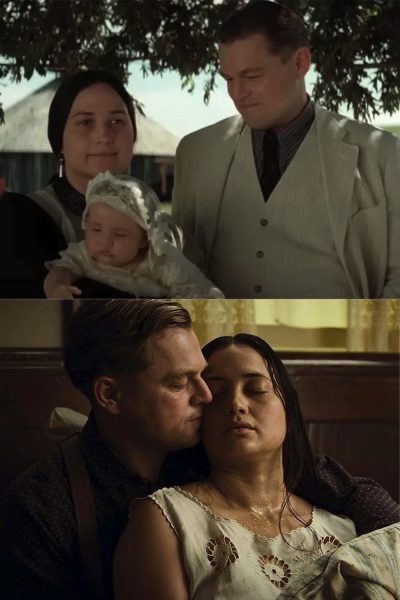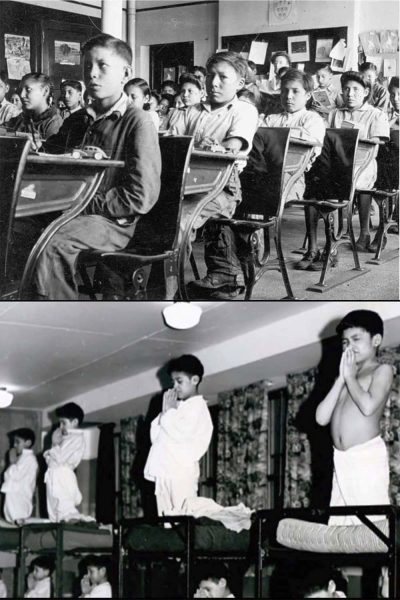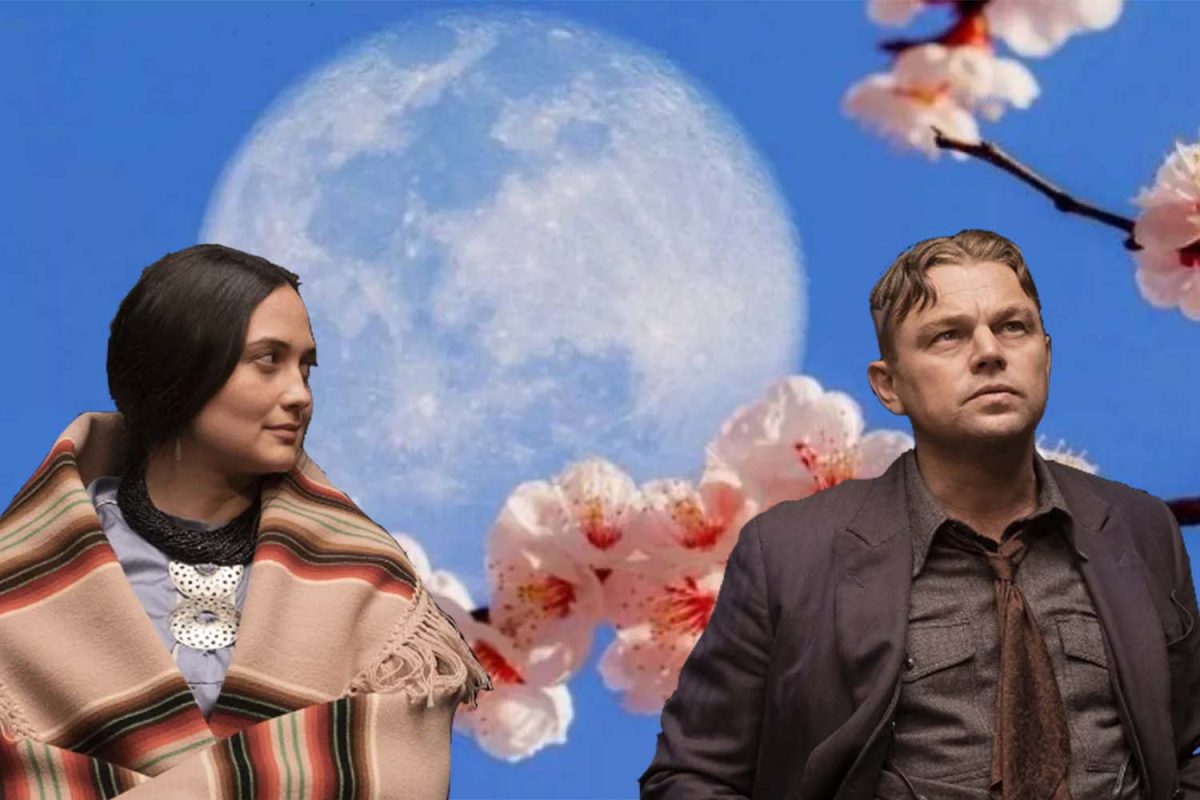Mr. Martin Scorsese’s newest feature-length film, Killers of the Flower Moon, highlights the power dynamics and manipulation that love and greed can bring into a relationship. The film opened October 20 to much critical acclaim, according to rottentomatoes.com. This true story, which Mr. Scorsese adapted from Mr. David Grann’s novel of the same name, centers around the mercenary murders of the Osage Nation and their connection to the formation of the Federal Bureau of Investigation (FBI). The nearly three-and-a-half-hour film unfolds from 1921 to 1926 and features actors Mr. Leonardo DiCaprio and Ms. Lily Gladstone as the central couple. The historical period piece grapples with the tragedy of the past and the dark sides of human relationships, yet evinces the triumph of the spirit of legacy and love.
In Killers of the Flower Moon, Ms. Gladstone portrays Ms. Mollie Burkhart, a woman living amongst her sisters and mother who receive inheritance due to their Osage heritage. In this case, the funds come in the form of headrights, a system in which the government distributed funds to tribe members after extracting oil from their land, according to npr.org. Mollie is a character who undergoes a dramatic emotional and physical reset in the film during the adversity she faces. She struggles to reckon the duties to her heritage and family with her love for her partner Ernest and the medical ailments related to her diabetes.

The film commences with the historical obstacles that Mollie’s tribe faced concerning the discovery of vast amount of crude oil on their land. As a result, the United States (US) government initiates payments to key tribe members for the resource, allowing generations of Osage descendants to accumulate great wealth over several decades. In fact, at the onset of the film, Osage County, Oklahoma, where the film takes place, was the wealthiest city per capita in the world.
However, underneath the glamor of prosperity, Killers of the Flower Moon underscores a lust for control and power from external forces: namely, non-Native men trying to capitalize on the inheritance of the Osage people. Mr. Scorsese adapts this struggle through his portrayal of the other half of the central couple: Mr. Ernest Burkhart.
Ernest is a veteran who served as a cook during World War I. After the war, Ernest’s uncle, Mr. “King” William Hale, urges him to relocate to Osage County in search of new opportunities. When Ernest arrives in Osage County and exits the train, Mr. Scorsese presents viewers with a juxtaposition. The audience sees the newcomers, most of them white, serving well-dressed, affluent Native people. From Ernest’s perspective, he fits into the bottom of the Osage social hierarchy. Yet, his presence will rapidly change this dynamic.
After meeting with King Hale, portrayed by actor Mr. Robert De Niro, Ernest starts to discover his uncle’s motivations for his presence in Osage County: namely, to make money off of the Osage tribe. Although King Hale has lived locally for decades and has close ties with many elder Osage, his underlying motive throughout the film is to cheat the tribe out of its headrights. Indeed, during a tea conversation, King Hale implies that his nephew should attempt to charm Mollie in order to acquire her inheritance. However, later on, the plot becomes more sinister.

Due to the family ties between Mollie, her sisters, and her mother, the former only inherits a percentage of her family’s headrights. Thus, after Mollie and Ernest marry, King Hale stages a coup with the help of Ernest to murder the remainder of her family to increase Ernest’s headright shares. Once the rest of her family is dead, King Hale, who has known Mollie since she was a child, plans to kill her himself. Ernest, for his part, is wittingly naïve to this part of his uncle’s plan. Although he claims throughout the film’s duration to love Mollie more than anything, including money, his greed is the driving force behind his decisions.
As a director, Mr. Scorsese is keenly interested in exploring the dynamic between warped love and greed. While it seems that a part of Ernest truly loves his wife, communicating with her in the Osage language and supporting her while she is bedridden from diabetes, the filmmaker insinuates that there is a mental deception occurring in both members of the couple. Notably, due to King Hale’s connections, Ernest secures insulin, a rare medication at the time, to help his wife survive. However, King Hale also suggests to his nephew that Ernest should add a small trace of an unknown liquid to Mollie’s medicine. As Mollie continues growing sicker and her hallucinations increase, the director reveals Ernest’s questioning of this addition. Yet, he still deceives himself and follows his uncle’s requests.
For Mollie’s part, she also ignores the hints of a linkage between her husband and the murders of her tribe members. Ms. Gladstone’s nuanced acting highlights her character’s witting naïveté to the audience, which is already aware of the danger surrounding her. Indeed, the film points to an overarching conflict between love and manipulation. Mr. Scorsese demands his audience discuss the multifaceted and inherently selfish and selfless duality of love and abuse.

This theme is particularly reflective of both the current and past struggles of Native people, particularly Native women. Over four in five Native women have experienced sexual violence, with 96 percent of these attacks coming from non-Native perpetrators. However, due to a legal loophole that places the onus of prosecution on the federal government, many of these cases never come to trial nor receive justice, according to nbcnews.com.
Additionally, in terms of religious power and abuse, some Native tribes have suffered at the hands of local and national spiritual leaders. In both the US and Canada, residential schools forced the assimilation of Native children and stripped them of their language and culture. Religious groups including Catholic missionaries and Jesuit priests facilitated some of these atrocities, representing yet another legacy of manipulation among Native peoples. Only recently have religious figures such as Pope Francis begun to acknowledge the harm these schools inflicted on more than 150,000 children, according to scinetificamerican.com.
The name of the film and book refers to the “Flower Moon,” which is an Osage term for the time in spring when buds begin to bloom, according to indiatimes.com. Correspondingly, Mr. Scorsese stresses the murders not only as heinous acts, but also as upholding the abuse of the beauty of the Osage culture and lifestyle. Indeed, while the film centers on romantic abuse, Mr. Scorsese also underscores the systemic prejudice against Native tribes through the village’s distrust of the police and government institutions.
Despite the undeniable tragedy of the historical events, the director chooses to end with a tone of hope and love. While the oil industry has taken a permanent toll on the lives of the Osage people, the concluding shot of the film centers a group of Osage people dancing in the shape of a blossom to commemorate the “Flower Moon.” Ernest is ultimately held accountable for his crimes, and Mollie flourishes, staying true to the roots of her family and culture. In the end, despite all the horror, Mr. Scorsese shows that love and heritage are stronger than greed, offering a message of strength to Native people past and present who have experienced the legacy of colonization.
Featured Image by Lindsay Taylor ’24




